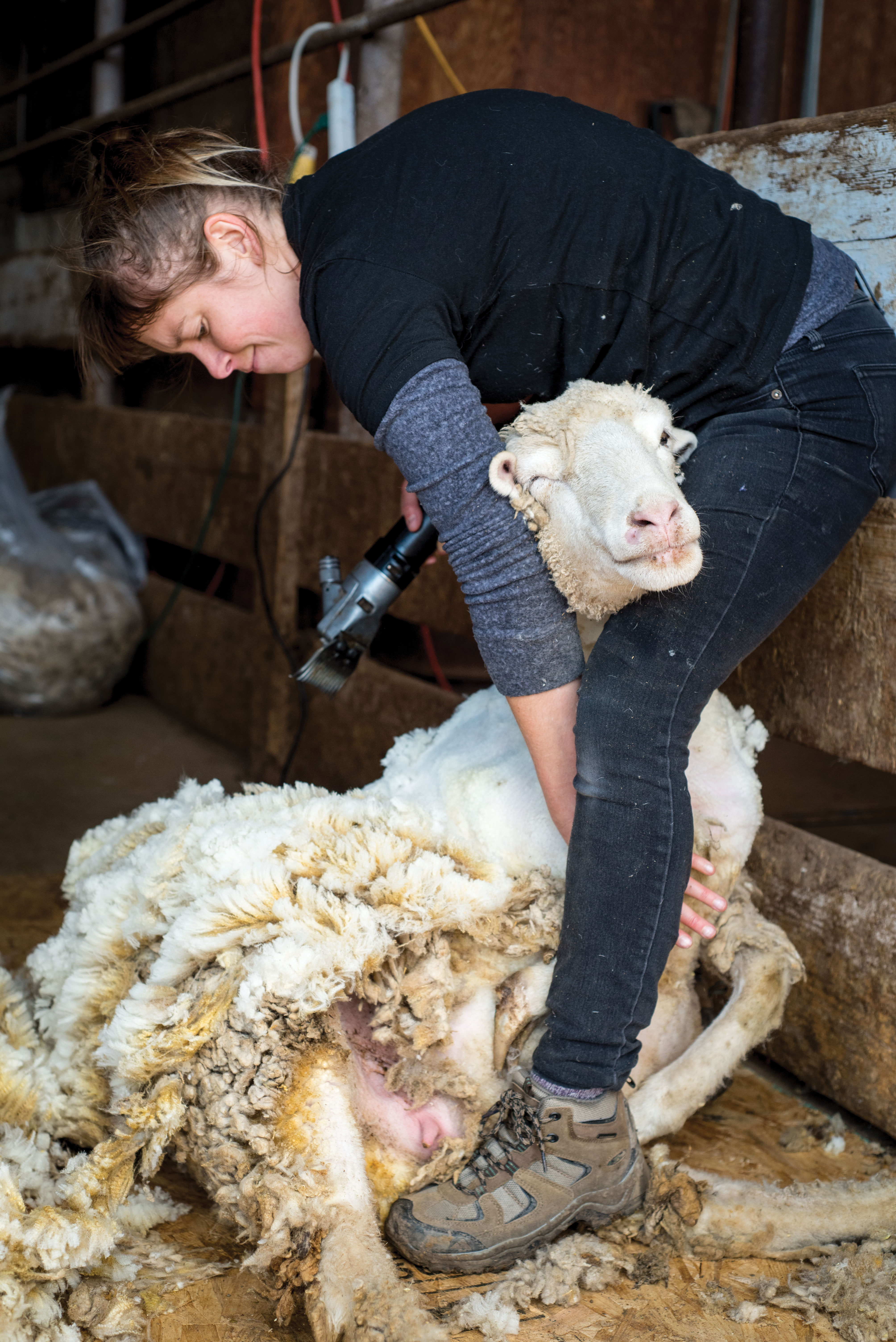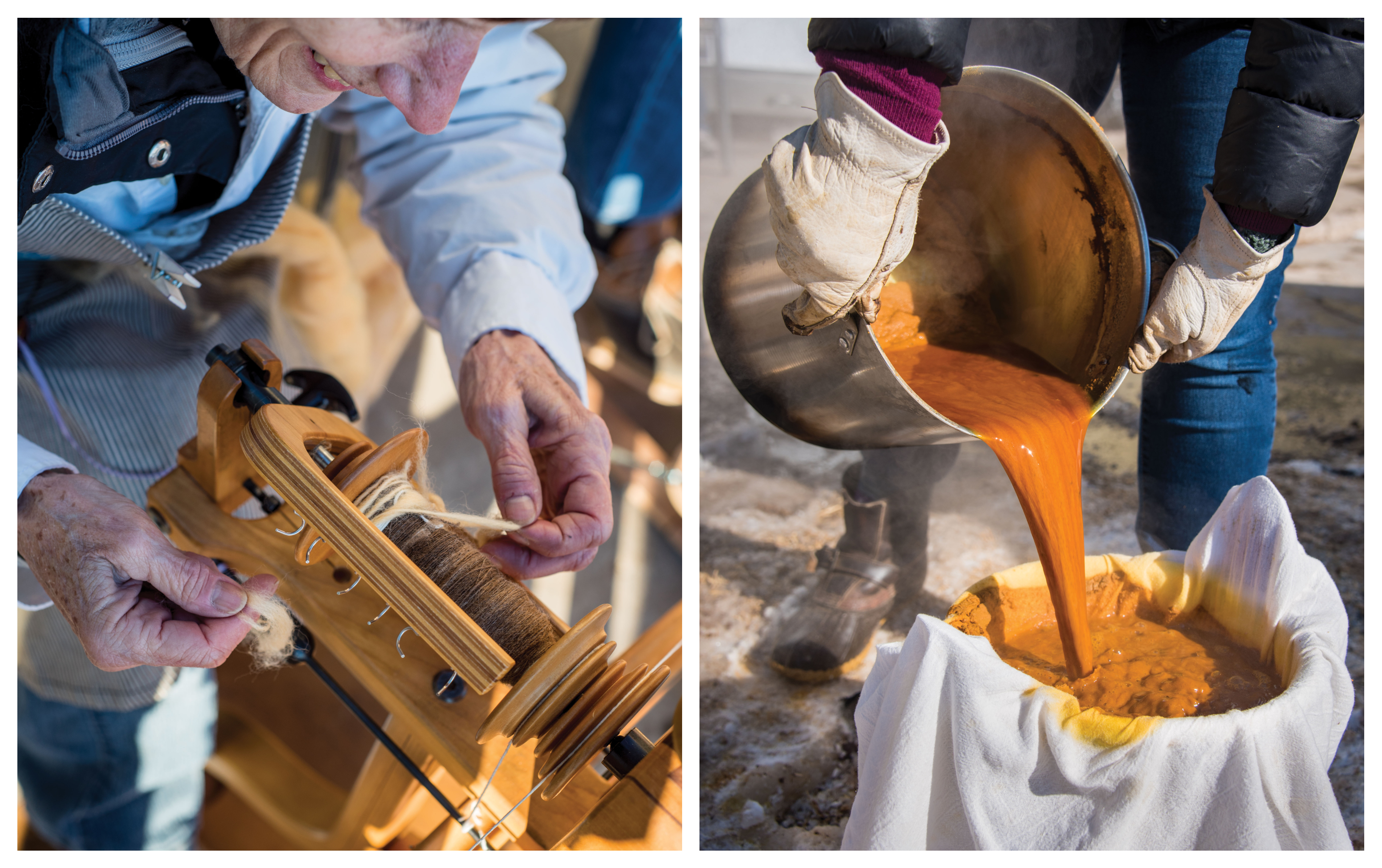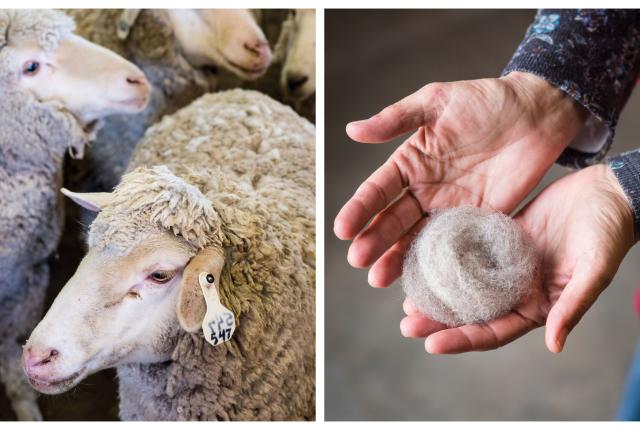Above: Kathleen Mower (right) holds a freshly cleaned and combed ball of sheep's wool. Photographs by Stefan Wachs.
LAST YEAR, TWO DAYS AFTER CHRISTMAS, I found myself shivering in a dusty barn in Belén, waiting for sheep to dry. Outside, six droopy-looking Rambouillets huddled in a muddy pen, seeming vaguely alarmed. Steam rose from their backs as the sun dissolved the remnants of the previous night’s snow. John Jewell, who was about to teach me how to shear a sheep, scratched his salt-and-pepper beard, shifted in his sturdy Key overalls, and anxiously eyed the animals as he set up his tools. You can’t shear wet critters or the fiber turns moldy, he told me and the other blinking, under-caffeinated students at this four-day Sheep Academy. And if you don’t keep them off their feed for 12 to 24 hours, he continued offhandedly, they’ll poop all over your boots when you shear.
Have the sheep fasted? I wondered. Suddenly I felt very awake.
Just then, more students arrived at the quiet cattle auction barn where Jewell led the first workshop. I met farmers Cody and Kim Burns, who had driven down from southern Colorado, and Pat Maas, who had nervously left her sheep in snowy McIntosh. There was Jens Deichmann, who keeps a couple dozen Churros grazing in his vineyard in Albuquerque’s South Valley, and Sandra Jones, a doctor from Las Cruces who had bought a few sheep and wanted her 13-year-old son, Robert, to learn how to take care of them. I huddled under a heater with Alora Fernandez, who used to work with the goats at Estancia’s Old Windmill Dairy but was dreaming of having her own operation, including sheep. All of us wanted to learn how to shear—me because I’m a nutso knitter who fantasizes about someday having sheep, them for more practical reasons.
Read more: Following the strands of New Mexico's staunch weaving traditions, from sheep to shop.
“The shearers are aging out, just like the ranchers,” says Katy Lente, one of the organizers of the academy. There is an urgent need for new people, young people, to learn from them and eventually fill their mud-caked boots. That’s one reason why Lente, state veterinarian Alexis Eckhoff, and some compatriots formed a group called the Oveja Project (oveja is Spanish for “sheep”), which hosted this first experimental Sheep Academy. Their vision for the future, Eckhoff says, is “a thriving sheep industry in New Mexico that is inclusive, sustainable, and economically viable.” For now, Sheep Academy is still getting on its feet, but ultimately Oveja Project aims to educate the public about sheep and make the sheep industry profitable by getting sheep-derived goods on the market. Organizers also want to embark on outreach between producers and young people, including 4-H groups all across the state.
The industry didn’t always struggle like this. Sheep were once the source of great fortunes for those living on the vast northern frontier of New Spain. They were of vital importance to the Spanish colonists, who chose to bring the low-maintenance Churro breed with them to the Río Grande Valley for meat and wool. Diné people acquired their own flocks through trade and raiding, making sheepherding and weaving cultural mainstays. The animals thrived on the open range. At one point the state’s five million sheep vastly outnumbered its human inhabitants. Roswell became a major trading point; it’s still home to the largest wool-marketing firm in the nation, claiming 20 percent of the domestic market, though it now sources wool from far beyond New Mexico. In 1918, Frank Bond built the Wool Warehouse in downtown Albuquerque to store five million pounds of wool and transport it to market on the Atchison, Topeka & Santa Fe Railway. Demand for wool peaked after World War I, in part because of the demand for military uniforms and blankets, but soon after that, wool began decades of decline with the influx of cheaper synthetic fabrics.
New Mexicans never forgot their love of wool. If you’ve ticked off even a few of New Mexico’s best experiences—the Museum of Spanish Colonial Arts, Indian Market, Spanish Market, and El Rancho de las Golondrinas, in Santa Fe; the Northern Navajo Nation Fair, in Shiprock; the New Mexico Farm & Ranch Heritage Museum, in Las Cruces; or the Heritage Farm, at the Albuquerque BioPark—then you’ve most likely admired rugs, blankets, embroidery, tapestries, and other works of art made with New Mexico wool and dyed with local plants. These cultural traditions are harder to maintain under economic pressures—younger generations leaving rural areas for urban ones, pastures going underutilized, and the lack of agricultural education for New Mexico youth. But there are still rural farmers trying to hang on to a way of life radically disrupted by globalization, as well as affluent city-dwelling fiber artists, knitters, crocheters, and spinners who love immersing themselves in the meditative, tactile pleasure of creating something tangible, unique, and lasting. They are proud descendants of New Mexico’s earliest fiber artists, devoted to preserving the cultural traditions of weaving, stitching, and dyeing. They are shearers, mill operators, veterinarians, butchers, and shop owners trying to keep afloat. They have banded together to try to find and then fix the dropped stitches in New Mexico’s sheep-to-shawl process.

Above: John Jewell is a Jedi with sheep.
EVENTUALLY THE MORNING WARMED up and Jewell led the driest-looking ewe into the barn. He stood her on a piece of plywood that he had laid down to catch the wool and keep it off the dirt. I had pictured us wielding something like the Wahl clippers I use to cut my husband’s hair, but Jewell had set up a bigger, more complicated contraption called a Supershear. The machine’s teeth did look similar, but it was attached, through a series of articulated steel tubes, to a one-half-horsepower motor he had bolted onto a wooden beam in the barn. “This is what the Aussies use,” he said, showing us how to remove the blades for sharpening. “Some of those guys shear 400 sheep a day.” Four hundred, I thought. Shearing must be easier than I imagined.
Jewell propped the docile critter up against his leg and slid the humming machine up and down her flank. It looked like what a brand-new Schick does when you slide it through the shaving cream on your shin. He zipped around a leg, ducked up under the neck, buzzed the “cap” off the top of her head. And he was done. “Okay! Who’s next?” he said, holding out the machine. No one moved.
Eventually, I volunteered. A helper led the newly nude ewe out to the corral and brought in a fresh, woolly one. During his demonstration, Jewell had shown us this Jedi move where he took the animal by the scruff of her neck and gently but firmly brought her head to her rear leg, smoothly guiding her into a sitting position. When I tried it, the sheep just stood there and stared at me like What the heck, crazy lady? It shook my confidence a bit. But Jewell showed me again. I didn’t really get it, but the ewe ended up with her butt on the ground. “Okay, now hold on to her neck. You’ve got to get her leaning against your left leg,” he said, “and use your right to pin back her foreleg.” I tried. It was like playing Twister with a sheep.
Read more: Artists We Love: Deborah Pierson.
I finally got her leaning up against me and Jewell pressed the machine’s handle into my palm, then reached up and flicked the Supershear’s switch. I gripped a fistful of wool and slid the machine’s tines into her fleece, but my forward progress immediately came to a thudding halt. It was like trying to jab a dull fork into a memory-foam pillow. I leaned my full weight into my right arm and took another pass down her side—and the cream-colored wool fell away, exposing bright-pink skin and a thin layer of snowy white fuzz. “Aaat’s it,” Jewell said.
By the third pass, I was starting to sweat. The more I pushed the vibrating blades under the fleece, the more my hand glistened with wool grease and the harder it was to hold on. I wiped a slick hand across the reinforced thigh of my pants and took a deep breath. I took several more passes down the right side, then aimed the tines toward the more challenging territory of her hind leg. I let her sink down to the plywood and she slumped at my feet like a bag of wet cement, looking as exhausted as I felt. I guided the machine down toward her haunch, but once I buried the tines in the fleece, I couldn’t see where they were going or how close they were to the skin. I pushed down on the ewe’s knee and she straightened her leg out, just like the instructor said she would. I kept the tines low, following the curve of her leg, and the wool came off in a nice wide strip. Within a few minutes I had nicked the poor girl. I wanted to give up. But Jewell (and Lente, who owned the ewe) urged me on. I’d been at it maybe 15 minutes. Sweat drenched my shirt. It wasn’t pretty, but I finished, then fell into a chair while the next student took a turn.

Above: Alora Fernandez practices shearing.
After lunch we had a session on trimming hooves. Sheep that live in a grassy pasture don’t wear their hooves down on their own, so you must trim them regularly. If not, they’ll grow gangly and curl up over themselves. “If they’re real long, horseshoe nippers will do the trick, but you can’t fix a severely overgrown hoof in one year,” hoof-trimming teacher Kerry Mower told us, holding a ewe by the ankle. Mower has a Ph.D. in animal health and works full-time for the New Mexico Department of Game and Fish, but he has a herd of Finn sheep and moonlights as a shearer. He drew a diagram of the foot, showing us how the hoof grows and how to avoid the quick, the soft tissue in the center of it. I snipped a piece of what felt like soggy rawhide off a sheep’s hoof. Nothing bled. I was one freshly trimmed foot closer to responsible sheep ownership.
Later that afternoon, we learned how to clean the sheared fleece, first by picking out all the burrs, bits of hay, and, rather unfortunately, poop. Afterward, we scoured it, cleaning all the grease out of the wool with repeated baths in hot, soapy water. Then came combing and carding the wool, the process of aligning its strands to ready it for spinning.
Today, you’re lucky if you earn $10 for a reasonably clean, nice fleece. The piecemeal pile I’d made that morning must have been worthless. Full-time rancher Cody Burns has figured out at least one way to make money at this. He and his wife raise a mixed herd of Merinos, Cotswolds, Gaddis, and Teeswaters. Professionals shear the bulk of their sheep, and they sell the wool wholesale, but Burns said he keeps the best of the animals aside for what he described as “the individual fleece market”—spinners, weavers, and dyers looking for top-quality wool they can finish themselves. Burns came to Sheep Academy so he could learn to shear those few animals himself and, importantly, on his own schedule. Their top-shelf fleeces might sell for $50 a pound, making just one worth as much as the fleeces of 50 run-of-the-mill sheep combined. But last year, they couldn’t get a single shearer to come in time for October’s Taos Wool Festival, one of their biggest events of the year. “Man, I coulda retired if I’d been able to shear them all before Taos,” he said with a laugh.
Read more: Follow the threads of creativity from animal to art.
By pursuing quality over quantity, Burns found a lucrative niche in a market that is otherwise saturated with cheap imports from Australia and New Zealand. Nothing can quite replace the connection customers make when they shake the hand of the man or woman who fed, cared for, and sheared the sheep whose fleece they’re buying. I get that. I live next door to a group of Churro and Rambouillet sheep, and a couple of years ago my neighbor, Raul Jaramillo, gave me a fleece. I had it processed at the Mora Valley Spinning Mill and used two skeins of it to knit a sweater for my cousin’s baby. It made my aunt cry, which made me cry. I had worked on the sweater for weeks, thinking often of Baby Evelyn, but also of the white sheep across my fence and the miracle that causes her to grow such a soft and luxurious coat.
A similar feeling of connection motivated Spanish Market colcha embroidery champion Julia Gomez to come to Sheep Academy as an assistant to natural dyeing instructor (and master spinner) Ric Rao. The temperatures never rose above freezing, but Gomez and fellow champion Annette Turk spent the entire day outside, lugging around giant, steaming pots of yellow snakeweed, oozing-red cochineal bugs, and deep-brown walnut husks. Rao had collected some of the plants himself, but he bought the cochineal bugs, which are easier to find and harvest in Mexico. It was hard, physical labor, but they were determined to teach us the old-fashioned way to color wool—the only real way to do it for traditional colcha embroidery, a rustic style of needlework that is beloved for its enthusiastic colors, whimsical flowers, and charming birds.
“I always think of the women who struggled here in colonial times,” Gomez said, “the women who sheared the sheep, spun the wool, wove the fabric, did the embroidery, and how much time it took.” She said she’d spent eight months working on the bedspread that won her a Best of Show award at Spanish Market in 2010. But Gomez was disheartened that only a handful of people had entered the colcha competition in 2018. “It’s a dying art,” she said with visible concern. That’s why she’s been mentoring young artists, demonstrating at El Rancho de Las Golondrinas, and helping with classes like this one. After lunch, she carefully tied lengths of churro yarn for me so I could try dyeing and have some little samples to take home.

Above: Workshop participants spin wool and dye it.
After all four days were over, Eckhoff proclaimed it a great success. “It taught a lot of people just how hard it is to shear sheep,” she said, laughing. “And it created a lot of connections. It created awareness, interest, and a love of something traditional that will continue to grow.” Craft stores in New Mexico are agitating for more local yarn, she says, and producers can’t meet the need. She’s hoping to put on more events that will bring sheep people together, including a follow-up to Sheep Academy.
Back at home, I realized I still had a lot of plain white yarn left in the Mora Valley Spinning Mill box, so I decided to dye it the way I’d learned. I boiled cochineal bugs, steeped black walnuts, and stirred up a pot of hollyhock blossoms I’d gathered from my yard, then dunked my yarn into the pots. It wasn’t a lot of wool—enough for a few baby sweaters—but as the hues emerged, my heart swelled with pride. I had made it myself.

ON THE FIBER TRAIL
The Oveja Project welcomes anyone interested in getting involved in elements of the sheep industry—breeding, farming, working with wool, or serving lamb in your restaurant. The project connects participants so they can share resources, knowledge, and training. Future workshops include a menu of options and prices. Contact Alexandra Eckhoff, of the New Mexico Livestock Board, at alexandra.eckhoff@state.nm.us, or Katy Lente at tiwaspeak@aol.com.
The Taos Wool Festival takes over Kit Carson Park October 5–6 for the 36th year. Stock up from the huge selection of local wool, fiber arts, tools, and more. Visit Critter Corner to ogle the alpacas, coo at the goats, and be growled at by a llama. Watch demonstrations and cheer for contest winners.
The Española Valley Fiber Arts Center celebrates Churro Week October 1–5, with classes in colcha embroidery and natural dyeing. The center also carries local yarn and supplies.
The Yarn Store at Nob Hill stocks yarn from Oveja Project members, offers a full range of classes, and hosts drop-in groups for knitters, crocheters, and spinners.
The Mora Valley Spinning Mill processes local fiber and leads tours of the factory. Shop for yarn and fiber arts in the adjoining Tapetes de Lana gallery. Call ahead to confirm hours.
Tierra Wools sells certified organic wool from local sheep and weavings by local artists in a cozy shop near Tierra Amarilla. Check the website for classes in weaving, spinning, dyeing, and more.
Visit the Sheep and Goat Barn at the New Mexico Farm & Ranch Heritage Museum, in Las Cruces, and sign up for felting and weaving workshops—some designed just for children.


